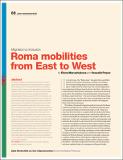Files in this item
Migration vs. inclusion : Roma mobilities from East to West
Item metadata
| dc.contributor.author | Marushiakova-Popova, Elena Andreevna | |
| dc.contributor.author | Popov, Veselin | |
| dc.date.accessioned | 2018-09-10T16:30:07Z | |
| dc.date.available | 2018-09-10T16:30:07Z | |
| dc.date.issued | 2018-09-06 | |
| dc.identifier | 252449597 | |
| dc.identifier | 061a84e3-ab3d-4dcb-a4e9-c67707fbe07f | |
| dc.identifier.citation | Marushiakova-Popova , E A & Popov , V 2018 , ' Migration vs. inclusion : Roma mobilities from East to West ' , Baltic Worlds , vol. 11 , no. 2-3 , pp. 88-100 . < http://balticworlds.com/migration-vs-inclusion-roma-mobilities-from-east-to-west > | en |
| dc.identifier.issn | 2000-2955 | |
| dc.identifier.other | ORCID: /0000-0001-5333-2330/work/48321995 | |
| dc.identifier.other | ORCID: /0000-0002-6565-8730/work/48321998 | |
| dc.identifier.uri | https://hdl.handle.net/10023/15999 | |
| dc.description | Funding: “RomaInterbellum. Roma Civic Emancipation between the Two World Wars” which has received funding from the European Research Council (ERC) under the European Union’s Horizon 2020 research and innovation programme (grant agreement No 694656). | en |
| dc.description.abstract | Historically the Balkan region is known as producing the East-West European Roma migrations and the current Roma mobility is not an exception. The Roma migrations, which already became topical nowadays, prompted policy attention to issues of Roma inclusion first in the East, but then also in the West. Inclusion policies have, by enlarge, failed to improve the situation of Roma communities. In order to achieve a better understanding of these issues, we argue that attention should be paid to Roma as distinct ethnic communities that are however an integral part of their respective civic nations. In the premodern past, Roma migrations mostly interested the Roma as ethnic communities of itinerant service providers looking for new markets at times of uncertainty. Contemporary migrations involve the Roma as part of their societies, that it is, they migrate together and for the same reasons as their fellow nationals. Some Roma, however, still migrate as ethnic communities, for example by applying for asylum on the basis of minority rights violations or by engaging in stigmatised economic activities. Migrations as a society and as an ethnic community are unevenly represented in policy and in academic debates, with the latter type dominating both and, to some extent, normalising a representation of the Roma as a community is in constant need of support. This view has led to a proliferation of mediation and training projects aimed at supporting local authorities in their engagement with Roma migrants but not equipping them to independently cope with life in the host countries. A further overlooked issue is impact of the migration of the most active part of Roma communities in East on Roma inclusion in their home countries. As a consequence, the results of policies targeting Roma are completely opposed to their stated objective and rather than promoting inclusion are contributing to the maintenance (or even to worsening) of the current situation. | |
| dc.format.extent | 334011 | |
| dc.language.iso | eng | |
| dc.relation.ispartof | Baltic Worlds | en |
| dc.subject | Roma | en |
| dc.subject | Community and society | en |
| dc.subject | Migration | en |
| dc.subject | Mobility | en |
| dc.subject | Integration | en |
| dc.subject | Inclusion | en |
| dc.subject | H Social Sciences (General) | en |
| dc.subject | T-NDAS | en |
| dc.subject.lcc | H1 | en |
| dc.title | Migration vs. inclusion : Roma mobilities from East to West | en |
| dc.type | Journal article | en |
| dc.contributor.sponsor | European Research Council | en |
| dc.contributor.sponsor | European Research Council | en |
| dc.contributor.institution | University of St Andrews. School of History | en |
| dc.description.status | Peer reviewed | en |
| dc.identifier.url | http://balticworlds.com/wp-content/uploads/2018/09/BW-2-2018-HELA.pdf | en |
| dc.identifier.url | http://balticworlds.com/migration-vs-inclusion-roma-mobilities-from-east-to-west | en |
| dc.identifier.grantnumber | 694656 | en |
| dc.identifier.grantnumber | 694656 | en |
This item appears in the following Collection(s)
Items in the St Andrews Research Repository are protected by copyright, with all rights reserved, unless otherwise indicated.

